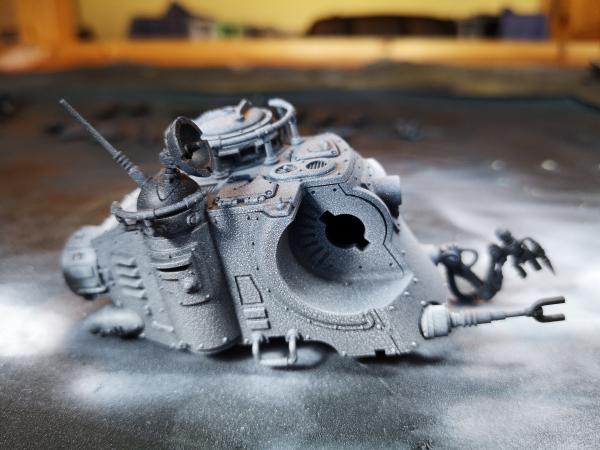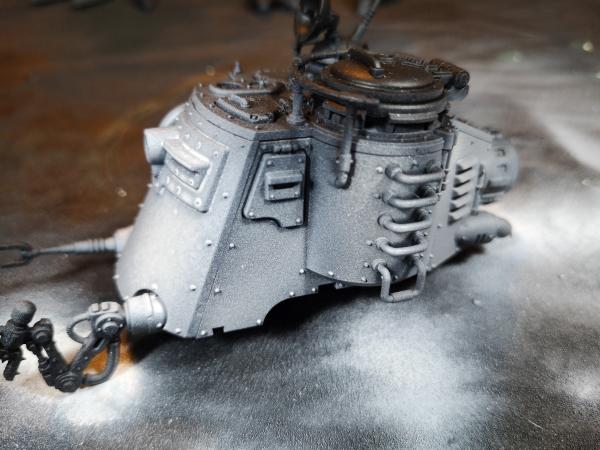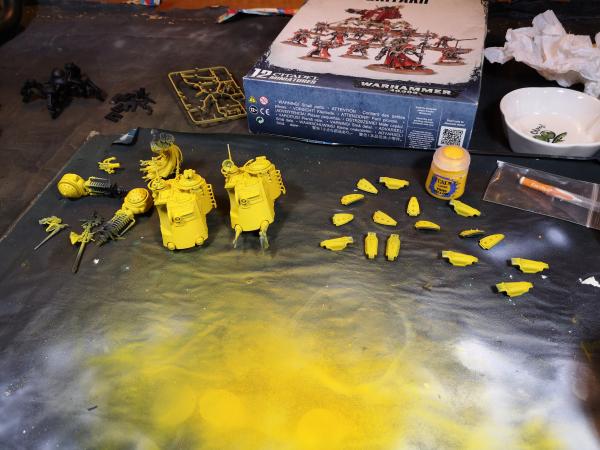Home › Forums › Painting in Tabletop Gaming › Looking for some help with my Airbrush.
Tagged: Airbrushing, painting
This topic contains 15 replies, has 11 voices, and was last updated by ![]() timchubb 5 years ago.
timchubb 5 years ago.
-
AuthorPosts
-
November 14, 2019 at 11:28 am #1456800
Hails all,
I’m a novice airbrusher and while I have used mine quite a bit since I got it (mostly simple basecoats) I don’t know enough about it to recognise specific issues when I run into problems.
I’ve just started an Admech army and I’m airbrushing a white layer over black primer. The armour panels will be yellow eventually and I don’t want that going on over black. I’ve started on the cockpits of two Onager Dunecrawlers.
The first one went fine but when I started on the second I ran into difficulty. My airbrush keeps clogging. I’m using the GW air paint White Scar and it’s been thinned to a 50/50 mix with Forge World Medium (the thinner they had alongside their own air paint range). I switched to this after running into similar problems with GW’s Air Caste Thinner. The airbrush is an Iwata Eclipse and the compressor is an Iwata Smart Jet Plus. I’m working at a PSI of 20.
I’ve deep cleaned the airbrush and filled the reservoir with paint, yet within seconds of use I can hear a sputtering sound from the airbrush and my paint flow dies away to nothing. There’s still air coming through but no paint. If I gun the trigger it releases paint but clogs again in a second or two.
Another issue I’ve had is with the paint not taking to the mini properly. I’m not sure if this is related to the first problem or a separate blunder. The images below are the effect I’m getting. This is going on over GW’s Chaos Black primer.



This is really holding me up and I’d genuinely appreciate any advice from more experienced airbrushers on how to fix the problem(s).
Cheers in advance.
November 14, 2019 at 11:43 am #1456847The sputter I’m not sure on. Has the environmental conditions changed there recently? Has this 50/50 mix worked fine with this specific pot of paint before? Every paint is different, and there can be differences between batches and pots of the same paint. As a pot gets older it’ll often get thicker too. You might want to experiment with the mix?
As for paint not sticking, are you washing your models properly before painting? The only times I’ve seen a model repel paint was due to mould release agent remaining. Or at least that’s what I assumed.
November 14, 2019 at 12:11 pm #1456853I’m just getting into airbrushing myself, but from the testing and research I’ve done. White is a notorious one to cause issues. I’ve seen a lot of people use artists white ink instead as it causes less issues and a nicer finish.
When giving it a deep clean do you test the spray pattern with just water to check if it has any sign of a blockage?
The adhesion issue other than cleaning the model before like Lawnor said I have no idea.
Hope it helps.
November 14, 2019 at 12:24 pm #1456865I’m no expert, so I’m expecting to be corrected on a point or two of this, but here’s my own experience:
Most whites are very ‘chalky’. They have a tendency to dry and clog faster than other paints. It doesn’t seem to matter what brand. Greys can also be like that.
If your paint is not adhering at this point in the process, it’s not the model that’s the issue. It’s either the primer or the paint you’re using. The effects around the rivets look like pooling so it’s possible that, at least for those sections, there was too much wet paint applied, or the airbrush was too close to the model. It’s going on ‘wetter’ than you want.
As for the speckled pattern, again, you’re going to get that more often with whites, I believe for the same reason they dry and clog faster. Environment and other factors can affect all of these things.There’s a few of things you can experiment with. Try increasing the PSI, might help with the clogging, but pull the airbrush back some as well. You’re not doing detail work so no need to be careful with overspray, etc. You can get lubricant for the needle. That will help with ‘dry tip’ where the paint dries on the needle.
To cover the model in a way that avoids some of the pooling and speckling, try multiple very light coats.All of this, of course, takes some patience.
November 14, 2019 at 12:35 pm #1456866Going at the model with 20 psi is probably an issue. You can have clogs developing in the nozzle as the paint dries from so much airflow. Try dialing it down to about 12-15 if you can. I think Iwata might have a separate dial for variable pressure control outside of what your compressor pushes out.
Thinking about the paint there are different standards that milling of paint is done at. Airbrush paint is meant to go through some pretty small space. Inks, on the other hand, seem to be even thinner and can give good coverage. I’m having good luck with a white ink base for zenithal highligh and then gloss coating to avoid reactivating it once I put down paint on it. For you, with such large models, keep at the white paint. Set your pressure lower, mix your paint and backflush as you have, then try you airbrush. If anything else goes wrong I’d say try a flow improver from Vallejo as it’ll thin the paint but not dry it out as quickly. Remember, atmospheric moisture plays a factor as well to drying time. What you’re doing is running paint through a cold hair dryer and the stuff might just need help staying wet.
November 14, 2019 at 12:38 pm #1456867Firstly, my advice for painting yellow.
Don’t use a black or white primer, use brown.
Yellow works really well over a brown primer, you’ll see a massive difference!I’ve found with most airbrushing problems there are two solutions:
1) The brush needs cleaned more thoroughly
2) Adjust the mix of the paint.1) What are you cleaning the brush with? If it’s just water you need to use some form of airbrush cleaner.
I use two different types, one is vallejo airbrush cleaner (looks a lot like water), which is my main cleaner, in addition to this I use a solvent based airbrush cleaner that comes in a spray can. This is for the more stubborn to reach areas and only gets used on “deep” cleans.
Sometimes your brush will need to be “totally” disassembled (not to the point where every O ring is removed, use common sense when taking it apart for cleaning), but certinaly more than just taking the back off and removing the needle.
paint can get in the places you least expect it. ESPECIALLY if you’ve had a blockage at some point, as the paint has to go somewhere! so it’ll usually end up somewhere it shouldn’t inside the brush.Once you’re sure it’s 100% clean…
2) The mix of paint,
this is a really tricky one to diagnose and fix online, as there are lots and lots of things that can go wrong here.
the standard answer is to thin your paints to the consistency of semi skimmed milk,
if you do that, there’s less chance anything can go wrong, but it’s still quite vague.Do you mix your paint in the brush? or seperate? I tend to mix mine in shot glasses, then pour it into the brush as I need it. I also don’t overfill the cup on the brush, if there is a blockage, I want the minimum in there as possible.
If you mix in the bush, there’s a good chance you’ve forced a lump of the thickest stuff way down into the brush first before your thinned stuff, giving you an inconsistent mix (overly thinned at the top, not thinned enough at the bottom), and exponentially increased your chance of a blockage right from the word go.Is there any reason why you use the citadel stuff? I’ve not heard great things about the citadel air range, but honestly never tried it myself.
My collection of paints is a mix of old GW, vallejo & Army painter.
By far my . favourite is vallejo, I have very little issues with vallejo and the range of colours available is astounding, no matter the colour there will be a vallej equivalent!Paint not adhering tends to be a dirty model, usually mold release agent still on the figure.
Best course of action is to use warm soapy water to wash the model before priming.Hope this helps.
ThanksChris
November 14, 2019 at 1:04 pm #1456869Ok… there’s one thing that’s bothering me from these comments.
From the pictures, it looks like the primer adhered to the model fine. That means it is not a dirty model that’s the problem.
Let’s get specific. From the looks of things the primer adhered to the model but the white paint is not sitting where you want it over the primer.
I’m seeing what is called spider webbing, as well as pooling. Essentially you have two problems. The paint is drying too quickly in the brush, causing clogging, but when it works it is going onto the model too wet. The spider webbing happens when your airbrush is too close to the model and the paint is still wet.Angel Giraldez (pro-painter, known for a lot of great work, including the box images for Infinity and other model companies… has two great instructional books out, in fact) sets his PSI at about 24. However, he has top of the line equipment, thinners, flow enhancers, etc., so play around with lower and higher pressures and see what works for your situation.
As for the spider webbing and pooling, as I said earlier, try more thin layers and don’t hold the brush too close to the model.
Also, what primer are you using? I’ve had some that worked much better than others.November 15, 2019 at 12:52 am #1456999Cheers for all the replies guys. I’ve invested a lot in the airbrush paraphernalia so I really want to make proper use of it.
I’ve used this paint on two Imperial Knights before and it went on fine. I wash my models on the sprue and give them a scrub with an electric toothbrush. I use warm water and washing up liquid.
I generally dismantle the brush and clean it before each session. I use Acetone and a kit I got for cleaning them.
I’ve had that problem with whites and light greys before with brush painting but this is an issue I ran into with a brown last time I used the airbrush too. And again, it was a brown that I’d previously done an entire building and squad with. How does the lubricant work? I actually have a small tube of it but I assumed it was for the inner workings of the airbrush.
I actually have both of AG’s books, I really should dig deeper into them.
I use GW Chaos Black, it’s what I use for about 95% of the stuff I paint.
The compressor has a dial so I can drop the PSI down a bit easily. I’m based in Ireland so humidity isn’t too much of an issue
I use Acetone as a cleaner. I had airbrush cleaner from Iwata but Acetone was recommended on a video I watched. I run water through afterwards to clean away any residue. When I clean the brush I take apart the nozzle completely and remove the needle. I have spare paint pots that I mix my paint in so it’s always given a good shake before I pour it into the reservoir. I’ve always used GW as I find it really handy to have an exact match for regular painting. I have the Forge World range too. I’ve had good results previously with basecoats and simple shading.
Thanks again for all the advice guys, I’ll try out the various suggestions and let you know how I get on.
November 15, 2019 at 2:04 am #1457007I myself had many problems with clogging and tried many things. I tried cleaning, different psi settings, retarders and airbrush thinners of all kinds.
But in the end what solved my problem was using vallejo airbrush flow improver. I don’t know what this stuff is but it just works (Still need to make sure the rest works but at least I could finally test stuff and improve myself).
Its the only reason I can airbrush today without turning into a hulk every time, so I am a vivid advocate of that stuff.November 15, 2019 at 9:32 am #1457023“I generally dismantle the brush and clean it before each session. I use Acetone and a kit I got for cleaning them.”
You should be cleaning it after each session, not before. That way nothing has time to dry inside. It also means you’ll have minimal chance for residue from any cleaning agents still inside to ruin your paint. It also gives it time for any moisture inside to evaporate before use so it can’t alter your mixtures. I might be overthinking some of these points, but why take chances?
November 15, 2019 at 11:46 am #1457066I’ve been using the Vallejo airbrush thinner recently and have found a huge difference over other products I’ve used.
I also use their white primer (through the airbrush) and I have less issues with that than a lot of other whites.
I haven’t tried their actual flow improver, but if it’s anything like their other technical products, I’m sure it’s good.The only thing of theirs I’ve been disappointed with at all so far is their plastic putty. It sounds like it should do more than what it does, but it is still great for filling small gaps in small models as well as texturing surfaces. I’ve only been using their products for about a year though.
As for airbrush lubricant, I’m really not sure. I’ve not used the stuff myself. I’ve just seen it references in different tutorial videos, etc.
November 15, 2019 at 5:10 pm #1457214I have Iwata Eclipse (gravity feed, .35mm nozzle) and the spattering on your photo looks familiar. Most likely cause is that the nozzle is not actually clean. It might work well with paints with finer pigments, but with white the flow is not normal: the paint seeps out from the nozzle slow and is carried only with the air when outside the nozzle, almost like an external mix airbrush, resulting in a spray that not smooth as normally with Eclipse. The same could explain the painting not adhering, the thinned paint hits the model without mixing with air, thus not drying normally.
Have you cleaned the nozzle mechanically, i.e. not just with cleaning liquid? Eclipse nozzle is easy to clean with a reamer or a needle (don’t use your airbrush needle, you might easily bend it) . Make sure to get the side walls, not only the tip. Also clean the nozzle cap properly.
If you’re sure the nozzle is clean, the check the following:
– does the paint have lumps? Put some on palette, swirl around with a brush, tilt the palette. The paint should look absolutely smooth. Some people filter or sift through their paint to avoid lumps.
– is the nozzle cap properly screwed in? Don’t use force, but it should be fairly tight. If loose, it can cause the problem I described first. A
– is the nozzle cap seal (black O-ring after the threads) good?
– is the needle tip bent or the nozzle tip damaged?
November 22, 2019 at 11:24 pm #1459197” If I gun the trigger it releases paint but clogs again in a second or two.”
You have a clog. The technical term for this kind of clog is ‘a bugger’. It’s caused by a flap of paint that’s stuck on one edge. When the paint flows one way it lies flat (usually when you back-flow to try and clean it :-/) , and then it stand up causing a clog when the flow goes the other way. Interdental brushes can be used to run down the pipes and are way cheaper than airbrush specific products. You can get some uber thin paper cones from china that do the say thing but cost more.
November 23, 2019 at 12:06 am #1459200Thanks again for all the tips guys, I’ve implemented some and I’ll be putting in an order for supplies next month so I can get som of the products recommended here.
I lowered my PSI to 15 and increased the distance between the airbrush and the model. This improved things but I still had regular blockages.
That seems to have been largely due to the paint though. I switched to a thinned Yriel Yellow for the next layer and it went on much smoother. 30 minutes got me a finish I’d fought with white for hours to get to. The next couple of layers are using the Forge World paints and I’ve always found those really nice to use. They never need additional thinning.
 November 23, 2019 at 1:01 am #1459205
November 23, 2019 at 1:01 am #1459205I have 3 armies of yellow models, but start with a black primer, then Averland sunset, then a white zenith of thinned Vallejo Game Air Dead White followed by a zenith of Vallejo Med yellow to cover up the white.
From there it’s just a recess shade of 50% yellow shade and an edge highlight with Dorn Yellow.
-
AuthorPosts
You must be logged in to reply to this topic.









































































